A Conversation with Jean-Jacques Annaud, Director of "The Bear" (1988) |
Read more at in70mm.com The 70mm Newsletter |
| Interviewed by: Thomas Hauerslev. Interview transcribed by Mette Petersen. Conversation recorded at the Gentofte Kino. | Date: 17.03.2023 |
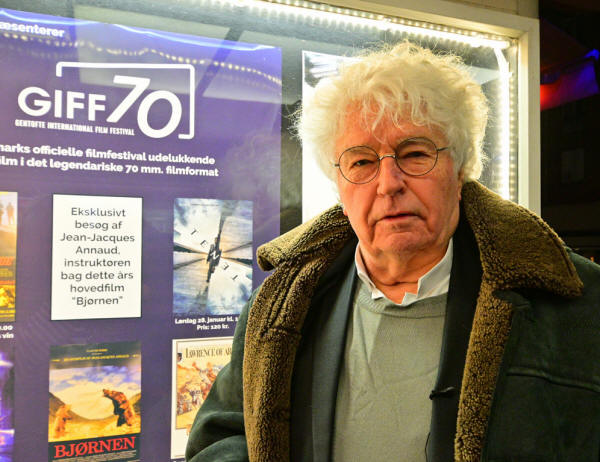 Jean-Jacques
Annaud
at the GIFF 70 festival, Gentofte Kino, 28. January 2023. Picture: Thomas
Hauerslev Jean-Jacques
Annaud
at the GIFF 70 festival, Gentofte Kino, 28. January 2023. Picture: Thomas
HauerslevThomas Hauerslev: I will start by going back a little bit. You represent the early French legacy of the anamorphic lens, the Hypergonar, developed by Professor Henri Chrétien [1879-1956]. The lens that was renamed "CinemaScope". Do you have any recollection of Professor Chrétien? Jean-Jacques Annaud: Yes, of course. Well, I think he was probably already passed away when I was at film school. One detail that I do remember - well, it was more than a detail: In the Cinémathèque Française, at Palais de Chaillot (Paris), strangely enough, the screen was not panoramic! It was not even Academy. It was a square! Why? Because the French Cinémathèque wanted to to be able to screen the first test of Chrétien's, who used his invention: CinemaScope [Hypergonar], not only horizontal but also vertical. In particularly he shot the Eiffel Tower in vertical [format] and I remember ... I was good at technology, when I was at Film School. I did two film schools, you know, the two that existed in France. One was called National School of Louis Lumière and also at La Fémis in Paris. In those days there were other names, but I enjoyed the technology, and the concept to compress the image and then stretch it out at the projection. What a great idea, and it was perfect for Westerns. In France we didn’t do that much 70mm for widescreen, because we were accustomed to shooting wide screen using 35mm anamorphic. And I shot half of my movies in anamorphic. What I like about anamorphic is that we use longer lenses, and you have less depth of field and therefore, you can have the background a little out of focus, which is better for the format. • Go to Jean-Jacques Annaud's Introduction to "The Bear" • Go to The Immersive Quality of 70mm Film THa: You are from 1943, and 79 years old. When you were a teenager, CinemaScope, VistaVision and Todd-AO, all emerged during the 1950’s .... JJA: Sure! I have seen it all! THa: ... did you see it and became inspired by it, or did it help you to decide to be involved with movies? JJA: Not necessarily, but I have seen something you didn’t even mention, its Cinerama. We had two Cineramas in Paris. We had the Russian one called Kinopanorama, and the US one called Cinerama. I have seen three or four shows. The first one was very good. The second not as good and the third one not as good, because they felt that the technology was enough and they didn’t know how to tell a story. But I have been curious all my life about all the technology you mentioned. I shot in VistaVision for my backgrounds in “Enemy at the Gates” (2001) with Jude Law and Ed Harris. I shot a lot of my backgrounds in VistaVision to get better better definition using the horizontal 35mm. I shot in IMAX 3D with the [IMAX] Solido camera. A movie called “Wings of Courage” (1996) and I was the very, very first to use that technology. Yes you know, people had forgotten about 3D and this is how my colleague James Cameron became involved [with 3D], because he saw my movie, and he decided to do the Titanic documentary ["Ghost of the Abyss" (2003)]. Beautiful images everywhere. Shot very, very far below the water, at the real Titanic wreck. Then I was approached by Douglas Trumbull, who invented Showscan, and he wanted me to shoot some of those shows. I didn’t like it, not because it was 65mm negative, but he was shooting at 48 frames per second ... |
More in 70mm reading: Jean-Jacques Annaud's Introduction to "The Bear" in70mm.com Interview & People A Picture Visit to Kino-Panorama in Paris, 1990 The Max Linder, A collection of pictures 1990-2008 Belguiral's Max Linder Panorama (FR) Belguiral's Max Linder Panorama (UK) Empire - Cinerama, Paris Kingdom of curved screen Trail of CinemaScope 70mm Cinema and Film in France Conversations with Olivier Brunet, "Fanny's Wedding" GIFF 70, 2023, Copenhagen, Denmark in70mm.com's Library Presented on the big screen in 7OMM Peripheral Vision, Scopes, Dimensions and Panoramas in70mm.com Interview & People |
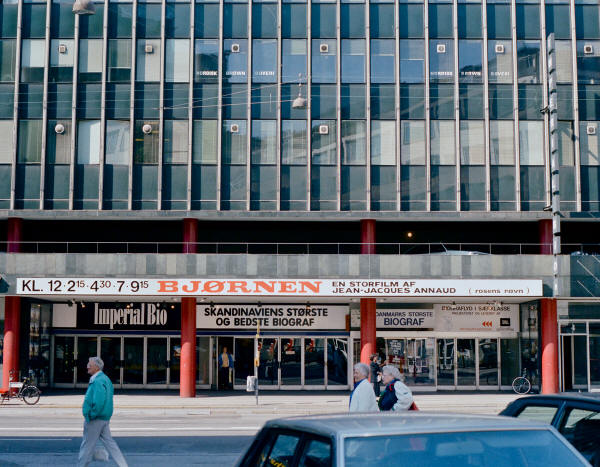 Jean-Jacques Annaud's "The Bear" premiered in Copenhagen
(DK) 18. August 1989 at
the Imperial Bio. Playing five times every day at 12:00, 14:15, 16:30,
19:00 and 21:15 in "sub-standard" 35mm format and Dolby Stereo. Last day
was 7.
September, and then moved over to Grand and Palads. Picture Thomas Hauerslev Jean-Jacques Annaud's "The Bear" premiered in Copenhagen
(DK) 18. August 1989 at
the Imperial Bio. Playing five times every day at 12:00, 14:15, 16:30,
19:00 and 21:15 in "sub-standard" 35mm format and Dolby Stereo. Last day
was 7.
September, and then moved over to Grand and Palads. Picture Thomas Hauerslev THa: 60 frames per second, actually. JJA: Yes, thank you for correcting me. I remember I was seeing the demos he had done. I didn’t like it. I hate those shaking seats and all that, so I didn’t do it. But I knew him rather well, and he kept me informed about his inventions. I also went digital very quickly. But at the very beginning, in 1995 I think, I shot the movie called “Two Brothers” (2004) featuring some tigers. Unfortunately in those days, the camera sensor was very small, and I didn’t really like the look of it. But now ... , you know the most recent movie I made, “Notre-Dame on Fire” (2022), I had an Alexa camera with an extra-large sensor, larger than 35, much larger ... THa: ARRI's Alexa 65 has a large format sensor. JJA: Possibly so. It was so surprising for me, because even on my viewfinder, I had to put marks myself because the ratio didn’t exist, but I had almost the resolution of an anamorphic, in terms of quality. I worked with [Cinematographer] Tonino Delli Colli on ”The Name of the Rose” (1986). Tony was used to shooting with Pier Paolo Pasolini, but also Sergio Leone, and they both used Techniscope! Two perfs! That had an interesting quality, because it was a little more grainy of course, but it was much cheaper because you would use a lot less film. Since “Seven Years in Tibet” (1997) I have been shooting full frame, you know using also the soundtrack area for extra picture image. THa: 4-perf Super Techniscope or Super 35 ... JJA: ... Super 35 absolutely. And now, recently, for “Notre-Dame on Fire” for instance, I intended to shoot a bit wider [aspect ratio] than I [normally] would. I think I was shooting 8k, so I can pan a bit inside the frame. |
|
 Jean-Jacques Annaud
at the GIFF 70 festival, Gentofte Kino, 28. January 2023. Picture: Thomas
Hauerslev Jean-Jacques Annaud
at the GIFF 70 festival, Gentofte Kino, 28. January 2023. Picture: Thomas
HauerslevTHa: You have been around when all the widescreen formats and technologies were introduced. Did you embrace them? JJA: [Enthusiastic] Yes, yes, yes ... you know, when I started very, very young, I was 19½ when I got my first paycheck, saying "Director", I was shooting black and white. All the TV commercials I did, for three or four years, were all black and white. Then I remember we were so surprised that we began to deal with colour. You know, the film stock was quite slow, about 25 ASA in the old days, and then we soon went to 64, oh my God! It was a revolution, and then we went to 400. It was fantastic [JJA's arms in the air]. THa: Can I take you back to the cinema today. Is it important for you that people see "The Bear" (1988) in 70mm compared to 35mm? JJA: Well, the immense difference is the sound because in the 35mm you are limited. THa: "The Bear" was perfect this evening. Wonderful pictures with Dolby Stereo. JJA: Yes it was. As I heard it in my sound stage. It was surprising today. You know I always do the color grading. Sometimes in association with my lighting camera man, but most of the time they are busy on another film, and so I do it with the colourist and what I saw today, was exactly what I wanted. And it is not always that way. When I supervise my movies being transferred in different format, I also supervise the grading. I remember a movie that I did “The Lover” (1992) in Vietnam, the digital version ended up being what I wanted when I shot it in 35mm. In Vietnam, I had a lot of very white skies and I had a Chinese actor, therefore in the film print I very often had to choose between his face or the skies. Of course the 35mm print exposure had to always be based on seeing his face. Then I rediscovered on the negative that I had both values captured in the exposure. So for the digital rendering I could get a perfectly good stop for my actor, and I could push the sky which were, as a matter of fact, not entirely white. There were nuances, there were clouds and all that, so I had a much better image today, than I had in the 35mm print. THa: Interesting. Sune asked you about “Wings of Courage” which was the first of your films shown in 70mm in Denmark, because it was shown in the local Omnimax cinema in '96. JJA: [Excited] Ahh, yes, yes, yes ... |
|
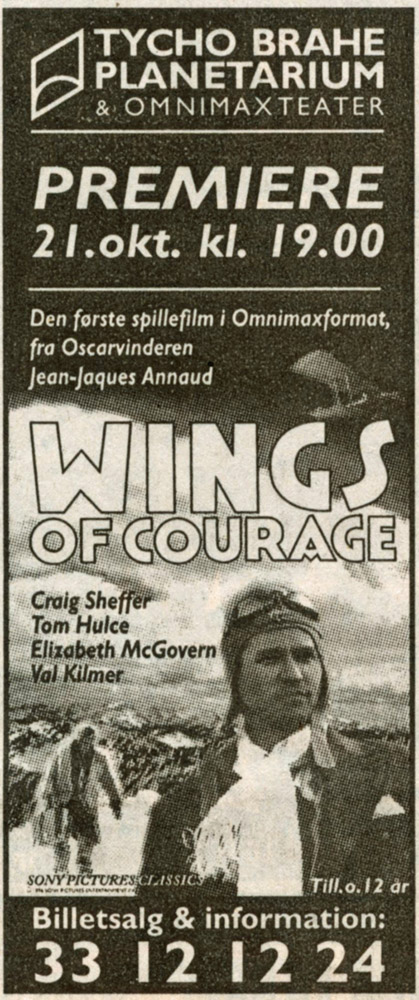 "PREMIERE
The first dramatic film in Omnimax format from Oscar winner Jean-Jaques Annaud".
Spot the error. Premiere 21. October 1996 in Omnimax 2D at the Tycho Brahe
Planetarium and Omnimax Teater, Copenhagen, DK. Newspaper advertising from
Editor's collection. "PREMIERE
The first dramatic film in Omnimax format from Oscar winner Jean-Jaques Annaud".
Spot the error. Premiere 21. October 1996 in Omnimax 2D at the Tycho Brahe
Planetarium and Omnimax Teater, Copenhagen, DK. Newspaper advertising from
Editor's collection.THa: Tell me a little bit about the making of that film, please. JJA: [Laughing] You know what, I went to Toronto, to see the people at IMAX, because they said "No, no, no. We cannot. It is impossible to shoot actors with our system". Because it was very noisy. It was very cumbersome – I was using - not only the Solido, but I was using two other cameras. A contraption I would say with two cameras, mirrors, and all that. The mirrors, as you know ... if it rains you can almost not shoot, because you have a drop [of water] on one image and not on the other. When you have dust, it is the same. So, it was very complicated, but I said to those people, I said: "I know that I can do it. It is spectacular. It is an extraordinary system, believe me", and they didn’t trust me. But very fortunately at Columbia/SONY they trusted me. They let me do it, but what I had to do was of course, to dub everything. Afterwards, I called my actors back. We had the [IMAX] cameras going like this skfjdkslfdlsjfdksfjdksfjdkslfjdklsjfdskl. I had three of them all the time! And the other problem was that I had only two minutes [of 65mm film] in my can. THa: 15 perf magazine quickly runs out ... JJA: I remember, I was saying "Roll Camera" and I was hearing a "Click" and then yaonk, yaonk and faster and faster [JJA simulates the IMAX camera going faster and faster], and then I said, "Can I say Action?" "Not yet Sir". [JJA and THa laughing]. It had to be at the right speed! But you know what is interesting in this, very recently I was invited to the Imax CEO forum at Scottsdale in Arizona and they really wanted me, because they said: "You changed the perception of Imax, because it was of THAT early movie. Not only it was a way to reintroduce 3D, but it had also helped Imax expand from their documentary specialty". They were absolutely convinced that their format was made for documentaries. They did excellent documentaries by the way, and thy revived documentary films, which disappeared in those days. So, now I have this very warm relationship with Imax for that reason, and most of my recent movies has been shown in Imax Theatres. I have done another genuine one with 3D cameras in China, a movie called "Wolf Totem" (2004). It did great in China, did okay good in other places, but a fabulous success in China and I shot real 3D with those bizarre cameras, those mirrors and all that. What I must say is, 3D is, if directors are not aware, that it is not the same kind of direction that you can do as for 2D. You cannot arrange your scenes the same way. Because you ask an effort from the audience, because what they see, you don’t have close up. It is not a close-up in 3D. It is the actor that come TO you. Like one meter away from you. Then you have to converge and to focus. If the next shot after that is a wide shot, where the focus is far away, the viewer gets a headache. The only way to do it, is to make sure that you understand which is the next shot and as you are not inside a frame, but you are inside a picture, you don’t see the limit and therefore it is very disturbing. And lots of people tell me that even for "Avatar" (2022) - and Cameron is a great specialist on 3D - but three hours of that, and people are getting a headache and the glasses come off. THa: I wear glasses and I rarely see 3D, also as a former projectionist I see everything that is not the movie [EXIT signs etc]. I get distracted wearing my own glasses AND 3D glasses. JJA: Of course. I know it has been in fashion on the last decade, but now only China is eager to see 3D. THa: Jumping back to "The Bear" again. When you shot the film with Philippe Rousselot, were you aware that it was going to be released in 70mm? Did you frame it for 70mm? Because the print has thick frame-lines to keep the entire 2,39:1 aspect ratio on the screen. JJA: Well, you know, my two previous movies ["Quest for Fire" (1981) & "The Name of the Rose"] were released in 70mm. So, yes of course I knew I would have prestige prints. I don’t know the exact number, but I think in the world we had like ... maybe 100 prints in 70mm? I know for France we had like ... I am not sure, but I think between 12 and 20 70mm prints. The movie was released in almost 500 theatres in France. Therefore you know, the proportion between 35 and 70mm is huge. It was unusual to see it in 70mm in those days, because most theatres did not have a 70mm projector. So, it [70mm] is a luxury. But I remember, I was mentioning these theatres like Kino-Panorama ... THa: -, and at Max Linder Panorama, Gaumont Ambassades and Forum Horizon ... at least four 70mm prints in Paris on the opening day! JJA: ... [Laughing] yes, yes, right, right, but you know, I remember in New York I had the Ziegfeld. I had the [Pacific’s Cinerama] Dome in Los Angeles. Both in 70mm. I had all the big cinemas everywhere. THa: Did you go to the premieres? JJA: Yes of course. Usually it is my duty to go, to do a little speech before with a Q&A [afterwards] |
|
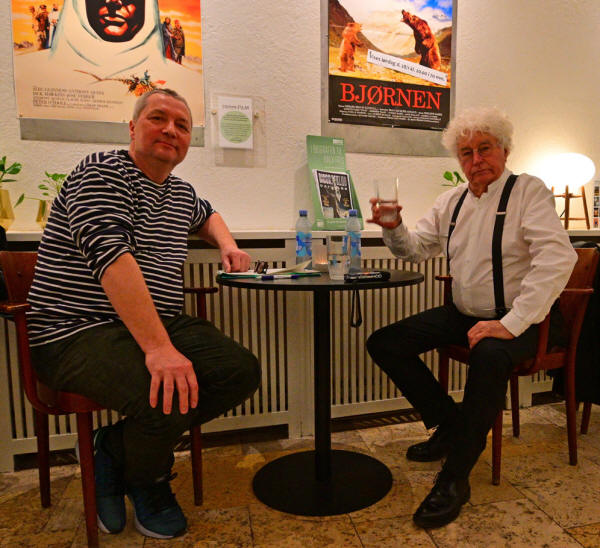 The
editor and
Jean-Jacques Annaud at the GIFF 70 festival,
Gentofte Kino, 28. January 2023. Picture: Charlotte Hauerslev The
editor and
Jean-Jacques Annaud at the GIFF 70 festival,
Gentofte Kino, 28. January 2023. Picture: Charlotte HauerslevTHa: Is it important for you to meet your audience? JJA: Well YES! ... you know, in my life, if I don’t do that, I am like spaced out, because my life is very pleasant [privileged]. I go from casting session to screening room, to a set and to where they build my sets. Therefore I see a lot of [people], you know, I have done this so many years, you know. For 60 years I have been doing this role. I have a different life, and if I don’t meet real people, for whom I work, it would be very silly. You know for this last movie of mine, I have already toured 35 countries. I have done, maybe more than 200 Q&A’s, because I go to Seville in Spain, and go to Lisbon, I go to Rome, I go to Milano, I go to Lucerne, Berlin, Munich, everywhere, and this is wonderful for me. This last movie is even more universal, you know. I would jump from Cape Town to Singapore, and get the same reaction, same moment, people with same surprise. So, if I don’t have these experiences, if I don’t talk to people, I am too much alone. Right now I spend a lot of my days preparing my next movie, reading all the scripts, helping another TV series to be made etc etc. I see composers, I see screenplay writers, I see a novelist, I go to very chic dinners. I am busy. It is a very privileged life, but I miss the roots. I love being here and hearing what people have got to say. It is interesting for me to hear the reaction today to a movie that is 40 years old. I am very pleased. When I travel, I usually look at the TV programmes in my room and almost everywhere there is one of my movies. I am explaining for my young colleagues, I am saying, "Why is it that you want to be a director"?. They say: "Ah, because we will go to Cannes, and go on the red carpet". I am saying, "Well, don’t believe that you will go, and if you are invited with a film, that day is a frightening day. It is one of the worst days of being a director." You know it is tough. My pleasure is to have this life full of ... I go to Abbey Road in London where I do all my music, I spend weeks and weeks with my composer. The same thing in preproduction. I spend weeks with my art department to build my sets, I spend weeks of course, when I shoot with my DoP and my first assistant. It is a wonderful, wonderful life, but I absolutely need that time. This movie – “Notre-Dame on Fire”, we first filmed in France and Belgium, and for the last 6-7 months I have been travelling. |
|
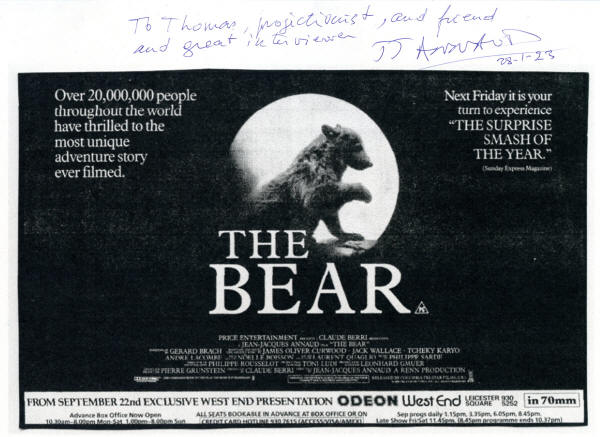 "The
Bear" advertising from London, UK. Premiere 22. September 22, 1989, and playing
until 19. October 1989 in 70mm at the Odeon West-End (Source: 70mm Expert
John Sharp) "The
Bear" advertising from London, UK. Premiere 22. September 22, 1989, and playing
until 19. October 1989 in 70mm at the Odeon West-End (Source: 70mm Expert
John Sharp)"The Bear" opened 19. October 1988 in Paris with at least four 70mm prints: Kino-Panorama, Max Linder Panorama, Gaumont Ambassades and Forum Horizon, (Source: 70mm Expert Francois CARRIN) THa: That is nice. JJA: Yes, it is nice. I remember being here in this cinema with a full room full of guests and I did a Q&A. I did four cinemas here in Copenhagen. I love it! THa: "The Bear" got a huge applause this evening. That was wonderful. I have one last question. Do you think there is a future for 70mm films? JJA: No! THa: Why is that? JJA: Because shooting in 70mm is a no longer a big deal. The cameras are too heavy. You cannot move the camera easily. You have to have a big crane. The very fast cranes we have with all the Lumar [cranes] and all that, they are not adapted to those big cameras, and it is very expensive. Today I think using 70mm is something for snobs. What is good is to see old movies in 70mm, and I wish that more labs would be able to make such prints. When I see movies done in 70mm, they are obsolete, because today you have to move your camera quicker, and the sheer weight of the [65mm] camera does not allow you. If I use a digital camera, I can use a drone for instance from here to there. Can I do that with a 70mm camera? No, then I would have to hire a helicopter. I have done 1000s of hours in a helicopter. Frankly I prefer the drones. With helicopters you cannot go close to your actors, there is too much dust and too much noise, and it frightens all the animals around. You got the dogs barking everywhere. No, no, no, no, I was sort of "drunk" on helicopters. "Wings of Courage" was helicopter every day. Three hours of helicopter every day. To get there and come back, plus the shot I did with the stabilizer camera. You have the problem renting a crane, for a 70mm camera that is too heavy, ... first they are not available anymore. They are in cinémathèques or exhibited. I have used all those things – you know those Chapmans [cranes]. They have been my life, being tied on with a belt on those Chapmans that are coming from Samuelson's in London, so you know I am very used to working with this equipment. Why would I go back to have something that I [now] can get better, quicker, cheaper? THa: Merci Monsieur. |
|
| Go: back - top - back issues - news index Updated 22-01-25 |
